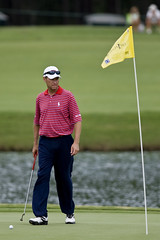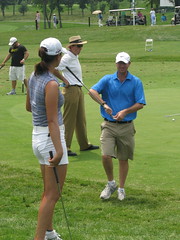Developing Optimal “Muscle Memory”
 Photo by nimeckOkay, I know what some of you purists are saying: there is no such thing as “muscle memory” because muscles don’t have memory. Strictly speaking, this is obviously correct, and “motor memory” would be more accurate. However, the phrase “muscle memory” is so commonplace and the meaning so descriptive that I believe it does have its place in our golf teaching lexicon.
Traditional teaching goes something like this: the student hits a few balls, the teacher diagnoses the problem and cure, and then has the student try the new movement. All of this is well and good, but is this truly the best way for a student to learn?
There have been some fine motor learning articles published recently in Golf Teaching Pro, and certainly written by people more credentialed than I when it relates to this field. What I wish to add to the discussion are my observations as a golf teacher of practical applications on the lesson tee. When I am not working in my capacity as the National Course Director for the USGTF, I also serve as a teaching professional at Crosswinds Golf Course in Savannah, Georgia.
Golf Magazine also published some motor learning articles awhile back, mainly studies about which drills work best. They did have one article that was more general in the application of drills. Today’s norm is for a teacher to show a student a drill, have them perform the drill for a number of repetitions, and then have them hit balls with their regular swing. The Golf Magazine study showed this method is less than optimal.
Instead, the study suggested that the student should do the drill without hitting the ball, do the drill while hitting the ball, hit the ball with a “normal” swing, and then repeat the process. Like most teachers, I did it the “usual” way until I read this article. I started incorporating this new method, and I have to say that the transference of the drill to the normal swing seems to be better for most of my students.
Another issue in learning is the concept of distributed vs. massed practice. Distributed practice is where the rest time during an activity equals or exceeds the activity time, while massed practice is the opposite. Study after study confirms that distributed practice is better for learning than massed practice, and this includes golf. Yet, in golf, most players use a massed practice schedule. In other words, they practice by hitting shot after shot with little or no break. Even the pros do this for the most part.
Instead, for optimal learning, golfers should hit maybe 2-3 shots (which should take about a minute), and then take a one-minute break. Yes, I know – this is extremely difficult for most golfers to do, including myself. My compromise is that I will warm up in a massed manner, and then switch over to distributed if it’s a true practice session. For pre-round warm-ups, I mainly adhere to a massed schedule. This theoretically may not be ideal, but as I said, it’s difficult from a patience viewpoint to adhere strictly to a distributed schedule.
Another issue for learning is random vs. blocked practice. Random is where the activity changes with each repetition, while blocked is where the activity changes infrequently or not at all between repetitions. For example, in golf, random would be to hit a driver, then a 3-wood, then a 6-iron, etc. Blocked would be to hit the driver say 10 times, then the 3-wood 10 times, then the 6-iron 10 times, etc.
Research suggests blocked practice might be better for novices while random practice is better for advanced participants (http://www.abcbodybuilding.com/conditionsofpractice2.pdf). Other research suggests a combination of “random blocks” works even better. In golf, this would be something like hitting 2-3 drives, then 2-3 3-woods, then 2-3 6-irons, etc.
The theories behind these findings are quite fascinating, but they are beyond the scope of this article. Those interested in reading further in-depth should refer to the link listed in the prior paragraph.
A book that gained some renown was W. Timothy Gallwey’s The Inner Game of Golf, published in 1981. Gallwey’s main focus was on getting the golfer to feel what he was actually doing before making a change, instead of just trying to make a change.
So, what does all of this mean in the teaching and the learning of golf? In teaching, I almost never let a student hit more than three balls without taking a break. Usually this is in the form of some discussion between us. This avoids using too much of a massed practice schedule during the lesson.
I never let the student use the same club for the whole lesson, even with beginners. My students usually will use at least three clubs, even during a short 30-minute lesson. This gets rid of some of the blocked practice that so many teachers use, and incorporates at least some random aspect to the lesson.
I also like Gallwey’s idea of getting a person to feel what they are actually doing before trying to get them to make a change. One idea on these lines, and one I borrowed from another mental book on golf whose title I have long forgotten, is to have the student make a practice swing using their undesirable habit, make a good practice swing, and then tell me how they did it. For example, someone who comes over the top might tell me they did it by “throwing” their right shoulder out, but on a good swing they feel it moving down. I would then ask them to monitor what their right shoulder did while they hit the ball. This technique does work remarkably well in getting a student to make a change in relatively short order.
The days of Tommy Armour, when he sat under an umbrella sipping a drink while he dispensed advice to students, are long gone. The common practice of many of today’s teachers, where they have their students hit ball after ball after ball with little or no break, and other such non-productive practices should also be relegated to the dustbin of history. A knowledge of effective motor learning techniques is essential if the next generation of golf teachers is to succeed.
There are many other effective motor learning techniques that I did not discuss in this article, because it could take up the whole magazine. The bottom line is to continually learn in our profession, not only with the physical aspects of hitting a ball with a stick, but in the mental aspects, too.
Photo by nimeckOkay, I know what some of you purists are saying: there is no such thing as “muscle memory” because muscles don’t have memory. Strictly speaking, this is obviously correct, and “motor memory” would be more accurate. However, the phrase “muscle memory” is so commonplace and the meaning so descriptive that I believe it does have its place in our golf teaching lexicon.
Traditional teaching goes something like this: the student hits a few balls, the teacher diagnoses the problem and cure, and then has the student try the new movement. All of this is well and good, but is this truly the best way for a student to learn?
There have been some fine motor learning articles published recently in Golf Teaching Pro, and certainly written by people more credentialed than I when it relates to this field. What I wish to add to the discussion are my observations as a golf teacher of practical applications on the lesson tee. When I am not working in my capacity as the National Course Director for the USGTF, I also serve as a teaching professional at Crosswinds Golf Course in Savannah, Georgia.
Golf Magazine also published some motor learning articles awhile back, mainly studies about which drills work best. They did have one article that was more general in the application of drills. Today’s norm is for a teacher to show a student a drill, have them perform the drill for a number of repetitions, and then have them hit balls with their regular swing. The Golf Magazine study showed this method is less than optimal.
Instead, the study suggested that the student should do the drill without hitting the ball, do the drill while hitting the ball, hit the ball with a “normal” swing, and then repeat the process. Like most teachers, I did it the “usual” way until I read this article. I started incorporating this new method, and I have to say that the transference of the drill to the normal swing seems to be better for most of my students.
Another issue in learning is the concept of distributed vs. massed practice. Distributed practice is where the rest time during an activity equals or exceeds the activity time, while massed practice is the opposite. Study after study confirms that distributed practice is better for learning than massed practice, and this includes golf. Yet, in golf, most players use a massed practice schedule. In other words, they practice by hitting shot after shot with little or no break. Even the pros do this for the most part.
Instead, for optimal learning, golfers should hit maybe 2-3 shots (which should take about a minute), and then take a one-minute break. Yes, I know – this is extremely difficult for most golfers to do, including myself. My compromise is that I will warm up in a massed manner, and then switch over to distributed if it’s a true practice session. For pre-round warm-ups, I mainly adhere to a massed schedule. This theoretically may not be ideal, but as I said, it’s difficult from a patience viewpoint to adhere strictly to a distributed schedule.
Another issue for learning is random vs. blocked practice. Random is where the activity changes with each repetition, while blocked is where the activity changes infrequently or not at all between repetitions. For example, in golf, random would be to hit a driver, then a 3-wood, then a 6-iron, etc. Blocked would be to hit the driver say 10 times, then the 3-wood 10 times, then the 6-iron 10 times, etc.
Research suggests blocked practice might be better for novices while random practice is better for advanced participants (http://www.abcbodybuilding.com/conditionsofpractice2.pdf). Other research suggests a combination of “random blocks” works even better. In golf, this would be something like hitting 2-3 drives, then 2-3 3-woods, then 2-3 6-irons, etc.
The theories behind these findings are quite fascinating, but they are beyond the scope of this article. Those interested in reading further in-depth should refer to the link listed in the prior paragraph.
A book that gained some renown was W. Timothy Gallwey’s The Inner Game of Golf, published in 1981. Gallwey’s main focus was on getting the golfer to feel what he was actually doing before making a change, instead of just trying to make a change.
So, what does all of this mean in the teaching and the learning of golf? In teaching, I almost never let a student hit more than three balls without taking a break. Usually this is in the form of some discussion between us. This avoids using too much of a massed practice schedule during the lesson.
I never let the student use the same club for the whole lesson, even with beginners. My students usually will use at least three clubs, even during a short 30-minute lesson. This gets rid of some of the blocked practice that so many teachers use, and incorporates at least some random aspect to the lesson.
I also like Gallwey’s idea of getting a person to feel what they are actually doing before trying to get them to make a change. One idea on these lines, and one I borrowed from another mental book on golf whose title I have long forgotten, is to have the student make a practice swing using their undesirable habit, make a good practice swing, and then tell me how they did it. For example, someone who comes over the top might tell me they did it by “throwing” their right shoulder out, but on a good swing they feel it moving down. I would then ask them to monitor what their right shoulder did while they hit the ball. This technique does work remarkably well in getting a student to make a change in relatively short order.
The days of Tommy Armour, when he sat under an umbrella sipping a drink while he dispensed advice to students, are long gone. The common practice of many of today’s teachers, where they have their students hit ball after ball after ball with little or no break, and other such non-productive practices should also be relegated to the dustbin of history. A knowledge of effective motor learning techniques is essential if the next generation of golf teachers is to succeed.
There are many other effective motor learning techniques that I did not discuss in this article, because it could take up the whole magazine. The bottom line is to continually learn in our profession, not only with the physical aspects of hitting a ball with a stick, but in the mental aspects, too.






 Added to this, we have great weather (year round), sunny skies, warm oceans and friendly people. World-class hotels, incredible safari lodges and game reserves are to be found throughout the country. As a tour operator serving the international market, I have seen that our golf courses are less well-known than our other, more famous attractions. It is my aim to highlight the country’s top golf destinations and best-kept secrets to you over the months to come.
As I write this article, Sun City (the country’s main golf destination) is preparing to host the Nedbank Golf Challenge – previously referred to as The Million Dollar Challenge. It is being marketed as ‘Africa’s Major’ and the field includes Hunter Mahan, Henrik Stenson, Nick Watney, and Tim Clark. At the same time, the country is gripped with FIFA 2010 Soccer World Cup fever.
Added to this, we have great weather (year round), sunny skies, warm oceans and friendly people. World-class hotels, incredible safari lodges and game reserves are to be found throughout the country. As a tour operator serving the international market, I have seen that our golf courses are less well-known than our other, more famous attractions. It is my aim to highlight the country’s top golf destinations and best-kept secrets to you over the months to come.
As I write this article, Sun City (the country’s main golf destination) is preparing to host the Nedbank Golf Challenge – previously referred to as The Million Dollar Challenge. It is being marketed as ‘Africa’s Major’ and the field includes Hunter Mahan, Henrik Stenson, Nick Watney, and Tim Clark. At the same time, the country is gripped with FIFA 2010 Soccer World Cup fever.
 Golfing tours can be tailor-made to suite different traveler’s pockets as well as tastes, and South Africa is a good destination for the US market, as one dollar tends to buy you 7-8 rands (South African currency). Itineraries can include a Big 5 Safari mixed with a trip to Cape Town, the Winelands, a cultural tour, and a great golf track. The tented Lodge I mentioned above is Gorah Elephant Camp, my favourite Safari destination – you can have a look at the website at http://www.hunterhotels.com/gorahelephantcamp/ and Bushman Sands can be viewed at http://www.riverhotels.co.za/bushmans/. The boat cruise and golf track can be viewed in the gallery link.
Please feel free to e-mail me on ron.mackenzie@neoafrica.com.
Golfing tours can be tailor-made to suite different traveler’s pockets as well as tastes, and South Africa is a good destination for the US market, as one dollar tends to buy you 7-8 rands (South African currency). Itineraries can include a Big 5 Safari mixed with a trip to Cape Town, the Winelands, a cultural tour, and a great golf track. The tented Lodge I mentioned above is Gorah Elephant Camp, my favourite Safari destination – you can have a look at the website at http://www.hunterhotels.com/gorahelephantcamp/ and Bushman Sands can be viewed at http://www.riverhotels.co.za/bushmans/. The boat cruise and golf track can be viewed in the gallery link.
Please feel free to e-mail me on ron.mackenzie@neoafrica.com. 


